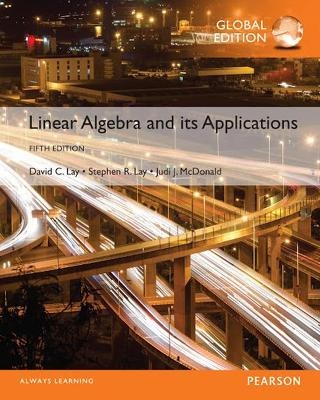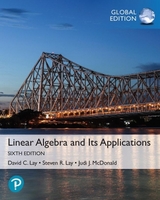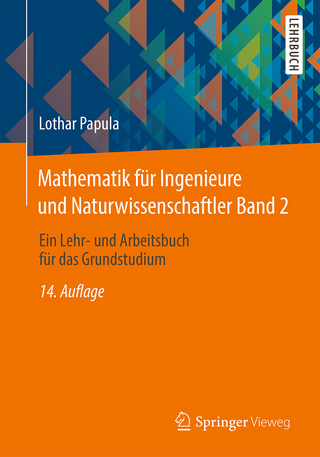
Linear Algebra and Its Applications, Global Edition
Pearson Education Limited (Verlag)
978-1-292-09223-2 (ISBN)
- Titel erscheint in neuer Auflage
- Artikel merken
With traditional linear algebra texts, the course is relatively easy for students during the early stages as material is presented in a familiar, concrete setting. However, when abstract concepts are introduced, students often hit a wall. Instructors seem to agree that certain concepts (such as linear independence, spanning, subspace, vector space, and linear transformations) are not easily understood and require time to assimilate. These concepts are fundamental to the study of linear algebra, so students' understanding of them is vital to mastering the subject. This text makes these concepts more accessible by introducing them early in a familiar, concrete Rn setting, developing them gradually, and returning to them throughout the text so that when they are discussed in the abstract, students are readily able to understand.
MyMathLab is an online homework, tutorial, and assessment product designed to personalize learning and improve results. With a wide range of interactive, engaging, and assignable activities, students are encouraged to actively learn and retain tough course concepts.
Please note that the product you are purchasing does not include MyMathLab.
MyMathLab
Join over 11 million students benefiting from Pearson MyLabs.
This title can be supported by MyMathLab, an online homework and tutorial system designed to test and build your understanding. Would you like to use the power of MyMathLab to accelerate your learning? You need both an access card and a course ID to access MyMathLab.
These are the steps you need to take:
1. Make sure that your lecturer is already using the system
Ask your lecturer before purchasing a MyLab product as you will need a course ID from them before you can gain access to the system.
2. Check whether an access card has been included with the book at a reduced cost
If it has, it will be on the inside back cover of the book.
3. If you have a course ID but no access code, you can benefit from MyMathLab at a reduced price by purchasing a pack containing a copy of the book and an access code for MyMathLab (ISBN:9781292092348)
4. If your lecturer is using the MyLab and you would like to purchase the product...
Go to www.mymathlab.com to buy access to this interactive study programme.
For educator access, contact your Pearson representative. To find out who your Pearson representative is, visit www.pearsoned.co.uk/replocator
1. Linear Equations in Linear Algebra
Introductory Example: Linear Models in Economics and Engineering
1.1 Systems of Linear Equations
1.2 Row Reduction and Echelon Forms
1.3 Vector Equations
1.4 The Matrix Equation Ax = b
1.5 Solution Sets of Linear Systems
1.6 Applications of Linear Systems
1.7 Linear Independence
1.8 Introduction to Linear Transformations
1.9 The Matrix of a Linear Transformation
1.10 Linear Models in Business, Science, and Engineering
2. Matrix Algebra
Introductory Example: Computer Models in Aircraft Design
2.1 Matrix Operations
2.2 The Inverse of a Matrix
2.3 Characterizations of Invertible Matrices
2.4 Partitioned Matrices
2.5 Matrix Factorizations
2.6 The Leontief Input–Output Model
2.7 Applications to Computer Graphics
2.8 Subspaces of Rn
2.9 Dimension and Rank
3. Determinants
Introductory Example: Random Paths and Distortion
3.1 Introduction to Determinants
3.2 Properties of Determinants
3.3 Cramer’s Rule, Volume, and Linear Transformations
4. Vector Spaces
Introductory Example: Space Flight and Control Systems
4.1 Vector Spaces and Subspaces
4.2 Null Spaces, Column Spaces, and Linear Transformations
4.3 Linearly Independent Sets; Bases
4.4 Coordinate Systems
4.5 The Dimension of a Vector Space
4.6 Rank
4.7 Change of Basis
4.8 Applications to Difference Equations
4.9 Applications to Markov Chains
5. Eigenvalues and Eigenvectors
Introductory Example: Dynamical Systems and Spotted Owls
5.1 Eigenvectors and Eigenvalues
5.2 The Characteristic Equation
5.3 Diagonalization
5.4 Eigenvectors and Linear Transformations
5.5 Complex Eigenvalues
5.6 Discrete Dynamical Systems
5.7 Applications to Differential Equations
5.8 Iterative Estimates for Eigenvalues
6. Orthogonality and Least Squares
Introductory Example: The North American Datum and GPS Navigation
6.1 Inner Product, Length, and Orthogonality
6.2 Orthogonal Sets
6.3 Orthogonal Projections
6.4 The Gram–Schmidt Process
6.5 Least-Squares Problems
6.6 Applications to Linear Models
6.7 Inner Product Spaces
6.8 Applications of Inner Product Spaces
7. Symmetric Matrices and Quadratic Forms
Introductory Example: Multichannel Image Processing
7.1 Diagonalization of Symmetric Matrices
7.2 Quadratic Forms
7.3 Constrained Optimization
7.4 The Singular Value Decomposition
7.5 Applications to Image Processing and Statistics
8. The Geometry of Vector Spaces
Introductory Example: The Platonic Solids
8.1 Affine Combinations
8.2 Affine Independence
8.3 Convex Combinations
8.4 Hyperplanes
8.5 Polytopes
8.6 Curves and Surfaces
Appendices
A. Uniqueness of the Reduced Echelon Form
B. Complex Numbers
| Verlagsort | Harlow |
|---|---|
| Sprache | englisch |
| Maße | 201 x 251 mm |
| Gewicht | 1040 g |
| Themenwelt | Mathematik / Informatik ► Mathematik ► Algebra |
| ISBN-10 | 1-292-09223-8 / 1292092238 |
| ISBN-13 | 978-1-292-09223-2 / 9781292092232 |
| Zustand | Neuware |
| Haben Sie eine Frage zum Produkt? |
aus dem Bereich



